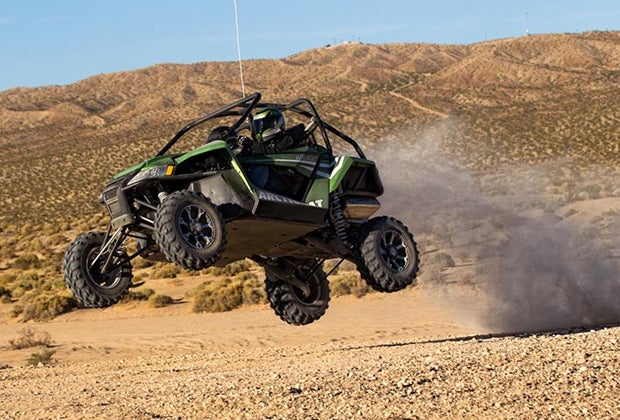
Arctic Cat is making noise with its new side-by-side, the Wildcat 1000i, a machine that may be wildest in the entire UTV industry.
Arctic Cat invited us to the Stoddard Wells ORV riding area in Barstow, Calif., to ride this impressive-looking new machine. With the thoughts of its massive suspension and powerful engine swirling in our heads, we were beyond excited to see if Arctic Cat could live up to its boastful projections, as the Wildcat 1000i has been the talk of the off-road industry for months.
Starting with the chassis, the Wildcat features a lightweight, tube base. This chassis not only took styling cues from the Class 1 buggy line, but it has a rock-crawler look that stands out as well. The weight in the chassis is rear biased 60/40, as the engine is mounted behind the cockpit. The engine is not the only thing behind the seats, as the radiator and most of the transmission components are as well. The only things we were able to see forward of the driver and passenger are a massive set of shocks, the front drive differential and a small oil cooler. The design is purposefully constructed this way to allow the Wildcat to stand up in the front and create balance when crossing rough terrain at speed.
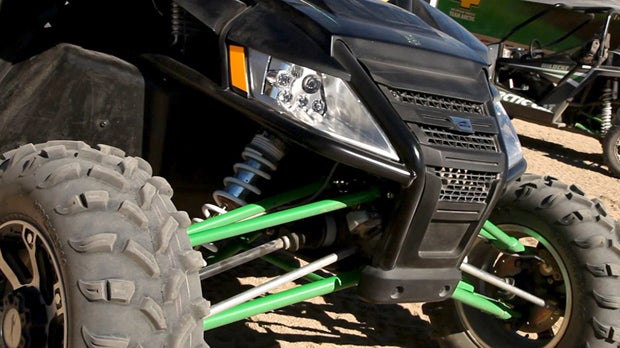
To aid in turning ability, the Wildcat features an electronic power steering system, but the suspension is where the Wildcat 1000i really excels. For starters, the rear of the Wildcat features an incredible 18 inches of travel; up front this cat stretches its arms out 17 inches. No other side-by-side comes close to these kinds of travel numbers. Polaris’ Ranger RZR XP 900 is next in line when it comes to suspension travel, but it has four inches less in the rear and 3.5 less in the front.
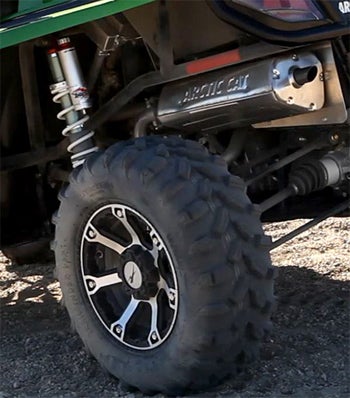
The five-point suspension in the rear and dual A-arms up front are held in place by Walker Evans shocks. These dual-rate shocks have several features that really make the suspension not only work well, but also lends to adjustment. The first of these adjustments and possibly the first type of adjustment of its kind in the side-by-side world has to be the crossover controls. The crossover spacer on typical dual-rate shock setups for ATVs or UTVs has to be physically removed and replaced with a different-sized spacer. The Walker Evans shocks have threaded adjustments, so owners can manipulate the tuning of the crossover rate. This is another first for a production machine and a bonus for side-by-side enthusiasts. These shocks also have multiple “clicks” of adjustment for the compression side of the shock.
The cockpit of the Wildcat 1000i is built to enclose the driver and the seated position is lower than its competition by five inches. Arctic Cat says this gets the driver and passenger down into the machine, which helps lower the center of gravity overall and delivers an “in” the machine feel. Seating in the Wildcat is very different than typical side-by-side seats. The seats are much wider and surround the driver and passenger to give a comfortable and tucked-in feel. Arctic Cat also included a three-point harness seat belt for both driver and passenger.
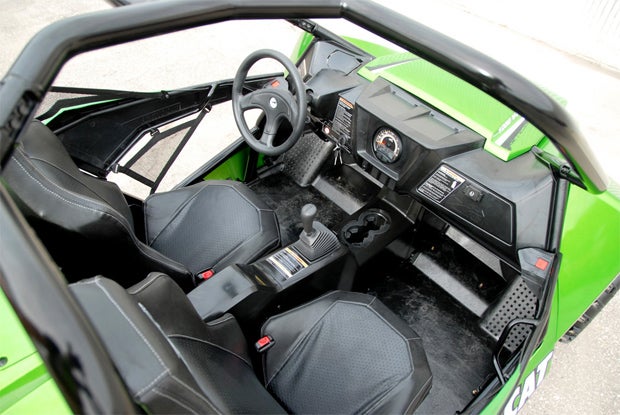
Though the suspension is the star of the Wildcat show, power is nothing to scoff at either. Arctic Cat has transplanted its 951cc, fuel-injected, fire-breathing V-Twin from the Prowler XTZ 1000. A CVT transmission delivers power into the gear box you have high, low, reverse, neutral and park as your choices.
Enough of the standards. Let's look at how this Cat prowls! In the wilds of Barstow, Calif., lies an ORV riding spot that gets many fast and well-suspended vehicles each year. This was a great place for testing the Wildcat and also one to showcase its drool-inducing suspension. Upon approaching the Wildcats under the Arctic Cat hauler we started to notice the exoskeleton-type framing on the beast. It reminds us of a desert race buggy and a rock crawler combined. That super long-travel suspension was the biggest eye catcher, though. After changing into our Fly protective gear and slipping into the cab, we started the newest Cat and headed out for a day of craziness.
Ride Impressions
The very first thing we noticed was the power in Wildcat. It wasn’t as explosive as we had envisioned. Some may say, “Well, do you really need that?” To those people we say, “Heck, yeah!” Torquey, responsive power can get you out of and keep you from getting into trouble, and with a suspension like this you can use everything you have and more. This could be just a clutching adjustment, but we are guessing that maybe fuel maps and some fine tuning would help as well.
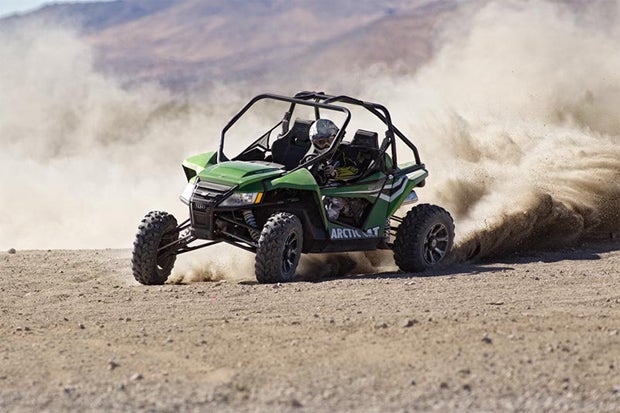
When we look at the Wildcat we think of an unbridled thrill-slinger from the word go, and yet it isn’t that complete of a package. Don’t get us wrong, as this machine has loads of power, but we think it just needs a bit more right off the bottom to make the driver feel like he has a 1000i in his control.
Our engine gripes aside, this is still the most thrilling ride we have ever experienced in a side-by-side. The suspension on this machine soaks up almost everything on the trail. There were times when we just knew we had bitten the last piece off, yet the Wildcat cradled our will and handed us the rite of passage over the toughest terrain we’ve seen since our last race south of the border in Baja.
At one point we found at least 50 yards of two- and three-foot deep whoops along one trail that, at speed, felt like small speed bumps as the Wildcat crested the tops with ease. We drove through the dust-blocked trail several times only to find ourselves with a decision to make, but once we had committed it was on! We’re not sure co-pilot (and videographer) Adam Wood has recovered yet.
The cockpit of the Wildcat kept us snug in its grip and with the reverse-opening doors, when it was time to get out and check our pants it was no trouble at all. You definitely sit down into the machine as we found ourselves bending over to slip in, almost like getting into a late-model dirt car.
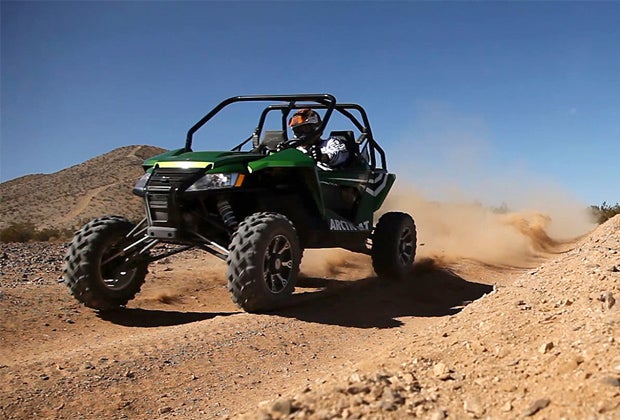
The dash is basic but the digital gauge has all the important info right in clear view just in case you need it. The monster seemed to get reasonably good gas mileage too, as we were not driving in ECO mode at all!
Steering the Wildcat was smooth and very comfortable with the help of Arctic Cat’s power steering. The wheel is closer than most we’ve driven, but as our guide Rick Wallace told us, this keeps driver fatigue down and we noticed that while on the ride.
Overall the Arctic Cat Wildcat 1000i is an awesome machine. It’s a thrill ride and if you get a chance to catch the Arctic Cat Wildcat Demo Tour you should try this one on for size. We suggest you bring a friend, though, because you’ll need someone to validate what you tell your buddies!
Pricing is not yet available, but we’ll let you know as soon as we find out. The Polaris Ranger RZR XP 900 retails for $15,999 and we wouldn’t be surprised to see the Wildcat end up in the same neighborhood.


 Your Privacy Choices
Your Privacy Choices